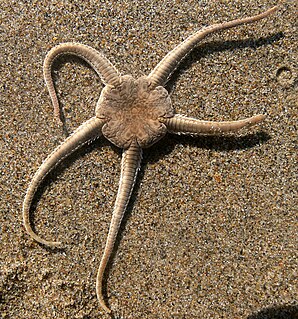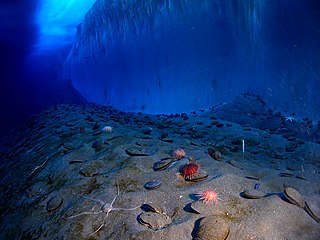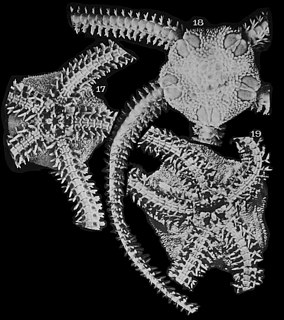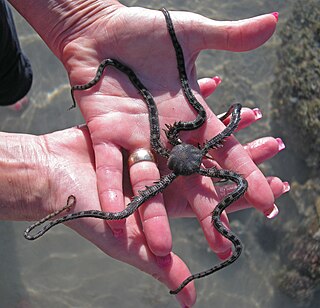
An echinoderm is any member of the phylum Echinodermata of marine animals. The adults are recognizable by their radial symmetry, and include starfish, sea urchins, sand dollars, and sea cucumbers, as well as the sea lilies or "stone lilies". Adult echinoderms are found on the sea bed at every ocean depth, from the intertidal zone to the abyssal zone. The phylum contains about 7000 living species, making it the second-largest grouping of deuterostomes, after the chordates. Echinoderms are the largest phylum that has no freshwater or terrestrial members.

Brittle stars, serpent stars, or ophiuroids are echinoderms in the class Ophiuroidea closely related to starfish. They crawl across the sea floor using their flexible arms for locomotion. The ophiuroids generally have five long, slender, whip-like arms which may reach up to 60 cm (24 in) in length on the largest specimens. From New Latin ophiurus, from Ancient Greek ὄφις + οὐρά.

Amphiuridae are a large family of brittle stars of the suborder Gnathophiurina. Some species are used to study echinoderm development and bioluminescence.
Ophiocanops fugiens is a living species in the brittle star family Ophiocanopidae. Though once considered to be the only one living species in this brittle star family, recent research has brought to light three specimens of Ophiocanops that differ substantially from O. fugiens. It has been regarded as the most primitive brittle star, close to Paleozoic forms, though other authors have disagreed with the view. Classification of O. fugiens is highly argued. Ophiocanops is usually placed in the order Oegophiurida or regarded as a genus incertae sedis or even given its own subclass Oegophiuridea. Some recent data suggest its relationship to the extant family Ophiomyxidae.

Ophiuridae are a large family of brittle stars of the suborder Ophiurina.

Ophiura ophiura or the serpent star is a species of brittle star in the order Ophiurida. It is typically found on coastal seabeds around northwestern Europe.

Ophionotus victoriae is a species of brittle star in the order Ophiurida. It has a circumpolar distribution around Antarctica.

Ophiocoma scolopendrina is a species of brittle star belonging to the family Ophiocomidae. Restricted to life in the intertidal, they live in the Indo-Pacific. They can typically be found within crevices or beneath borders on intertidal reef platforms. Unlike other Ophiocoma brittle stars, they are known for their unique way of surface-film feeding, using their arms to sweep the sea surface and trap food. Regeneration of their arms are a vital component of their physiology, allowing them to efficiently surface-film feed. These stars also have the ability to reproduce throughout the year, and have been known to have symbiotic relationships with other organisms.

Ophionereis reticulata, the reticulated brittle star, is a brittle star in the family Ophionereididae. It is found in shallow parts of the western Atlantic, Caribbean Sea and Gulf of Mexico.
Amphicutis is a genus of brittle stars of the family Amphilepidae. It contains a single species, Amphicutis stygobita.

Amphipholis squamata, common names brooding snake star and dwarf brittle star, is a species complex of brittle stars in the family Amphiuridae.

Ophiocoma echinata, the spiny ophiocoma, is a species of brittle star belonging to the family Ophiocomidae. It is the type species of the genus Ophiocoma and is found in the tropical west Atlantic Ocean, the Caribbean Sea and the Gulf of Mexico.

Ophiactis savignyi is a species of brittle star in the family Ophiactidae, commonly known as Savigny's brittle star or the little brittle star. It occurs in the tropical and subtropical parts of all the world's oceans and is thought to be the brittle star with the most widespread distribution. It was first described by the German zoologists Johannes Peter Müller and Franz Hermann Troschel in 1842. The specific name honours the French zoologist Marie Jules César Savigny.

Ophiopholis aculeata, the crevice brittle star or daisy brittle star, is a species of brittle star in the family Ophiactidae. It has a circum-polar distribution and is found in the Arctic Ocean, the northern Atlantic Ocean and the northern Pacific.

Acrocnida is a genus of brittle stars in the family Amphiuridae. The genus contains three members: Acrocnida brachiata, Acrocnida semisquamata, and Acrocnida spatulispina. There has also been observed hybridization between both Acrocnida brachiata and Acrocnida spatulispina. It is a fairly common genus, usually found along the coasts of Northwestern Europe, but with some species like semisquamata appearing around West Africa. Members of this genus primarily prefer intertidal and sub-tidal habitats, and they are they are less likely to be found in intertidal areas by comparison. This genus was not officially classified until 1926, by T. Gislén. One study found that due to the increased calcification that Acrocnida brachiata causes could be a potential source of Carbon Dioxide for not only the warm, shallow environments they live in, but also for the atmosphere.

Ophionereis schayeri, Schayer's brittle star, is a brittle star in the family Ophionereididae.

Ophiocomella alexandri, known as Alexander's spiny brittle star or banded brittle star, is a species of marine brittle star. It was first described to science by Theodore Lyman in 1860. Lyman states in his description that the animal is named for his friend, Alexander E. R. Agassiz, the son of Lyman's mentor, Louis Agassiz.














